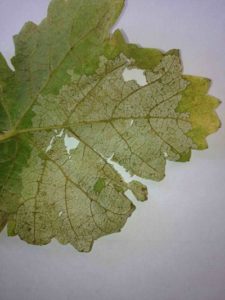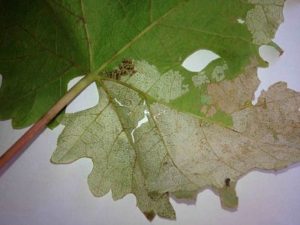Skeleton Leaves No More:
Permaculture’s Simple Secret for Banishing Pests
By Greg Peterson

So I am standing in my yard looking at my grapevine and some of the leaves have been reduced to a beautiful lacy, see-through tapestry. Uh oh!!! This year, it has skeletonizers, nasty little caterpillars that eat the green out of the leaves and leave behind the skeleton. I don’t have issues with these guys, or really any other bugs here at the Urban Farm…ever! Not that I don’t have bugs here, I just don’t have issues with bugs. Now, all of a sudden, I do. So what is going on and, better yet, how am I going to fix it?
In permaculture, one of the first tenets is observation and this has been drilled into me over the past 25 years. So, observation is the first thing I do when there is an ‘issue’ to resolve, and this can happen at different levels.
Observing the Space Through Time…
There is the observation of time, as in what happened in the past, and how does it inform and frame the future? There is the observation of small to large, such as the impact that small bug or a bunch of bugs has in an ecosystem. There is the observation of learning from the solutions that others and I have applied to adjust/fix the issue. So let’s observe:
- My first observation was the skeletonized leaves of my grape. This alerted me to the ‘issue.’
- This winter wasn’t much of a winter. It never froze here in Phoenix, something I have never seen in the 47 years I have lived here. This piece of data informs me that there will likely be more bugs to deal with in my area as the lack of cold makes it easier for bugs to survive.
- Are the caterpillars early in their life cycle, as indicated by a small amount of leaves being damaged, or are they later in their lifecycle, as indicated by a large amount of leaves damaged?
- I am sure there is more here. What might you observe for? Please list your ideas in our forum.
Creating a Plan…

Once you have collected your data it is time for action. What will my plan be for addressing the issue? In this case, I take my 3rdobservation from above and determine that these little guys are in the early stages of their development, making it very easy to address the issue. Observation: The early-stage skeletonizer caterpillars group together, huddling to keep warm and safe. This makes it very easy to harvest the leaf since they are all in one place. As the caterpillars grow, they separate and travel to different leaves, consuming much more and making it harder to get them all.
Armed with this piece of data, I scan the grapevine looking for individual leaves being eaten. Once found, I snap the affected leaf off at the trunk and take the leaves to the chicken coop. Another observation: The chickens love the caterpillars; they eat them and, given that bugs are 65% protein, they are nourished. Issue solved.
But wait—what if I miss the deadline and the caterpillars are occupying many leaves?
There are two natural solutions:
1. Pick them off individually (which is a lot of work) OR;
2. Use an all-natural product called BT (Bacillus thuringiensis), a natural bacteria which infects a caterpillar and kills them. Yes, the natural version of this bacteria is fine to use in our gardens.
So far, we have been looking at this process of issue elimination from a micro level and in a reactionary way: an issue happens and we react. What if we could do something (or many somethings) that would eliminate the need for us to have to react in the first place? In other words, what if there was no issue to deal with in the first place? The good news is that we can address this by looking at the general health of the plant and, better yet, the health of the soil.
I have found over and over again as I have planted, nurtured, killed, grown and harvested plants that the healthier the environment I provide, the healthier and less susceptible to all pests the plant is. Just like with our own health, the same goes for our plants. What can you do to create this awesome space for your plants to thrive? Glad you asked:
- Create and build healthy soil. I say add lots of organic matter, mulch and compost, especially in the summer. The deeper the organic material the better. Healthy soil contains 5 components:
– Dirt
– Air space
– Water
– Organic material (Best way to nurture life into soil)
– Everything that is alive; Bugs, microbes, mycelium and on.
2. Fertilize with:
⁃ An organic fertilizer
⁃ Micronutrients like rock dust, Redmon’s Conditioner or Elemite
⁃ Fish and kelp emulsion. These two products can be applied to the soil or as a foliar application directly on the plant leaves. This one helps a lot.
3. Water regularly and don’t drought-stress your plants.
The bottom line:
Pay attention to your plants and the environment around them. I am very much a proponent of working early so that later on down the road I don’t have to deal with an issue. It takes some forethought and observation, but once you do your garden and your life will be so much easier and healthier.
*Disclosure:
Some of the links in our podcast show notes and blog posts are affiliate links and if you go through them to make a purchase, we will earn a nominal commission at no cost to you. We offer links to items recommended by our podcast guests and guest writers as a service to our audience and these items are not selected because of the commission we receive from your purchases. We know the decision is yours, and whether you decide to buy something is completely up to you.








Companion planting is also a good idea. Not only can we integrate other plants that throw off pests when they don’t like the smell, but companion planting can also provide habitat for predatory insects and maybe even birds, as long as the birds themselves don’t become a problem of their own.
How can I kill them all most all my leaves have been eaten
How do you deal with squash bettles?